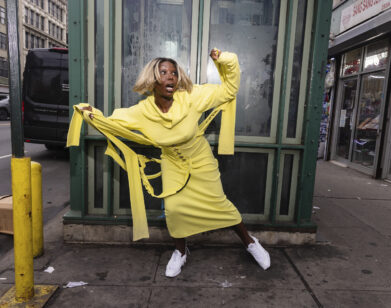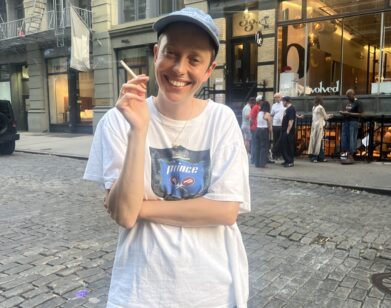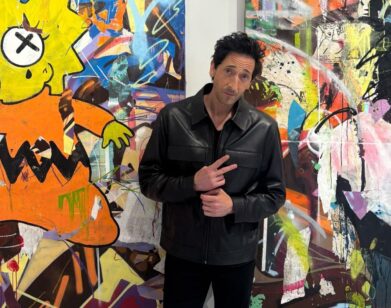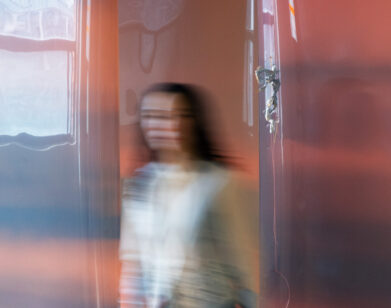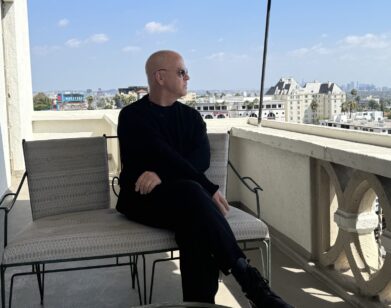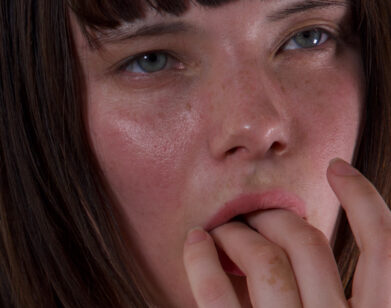Korakrit Arunanondchai

KORAKRIT ARUNANONDCHAI IN NEW YORK, MARCH 2015. ALL CLOTHING: ARUNANONDCHAI’S OWN. HAIR PRODUCT: ORIBE, INCLUDING GOLD LUST NOURISHING HAIR OIL. HAIR: BOK-HEE FOR ORIBE HAIR CARE/STREETERS. MAKEUP: YUMI MORI/THE WALL GROUP. SPECIAL THANKS: FAST ASHLEYS.
In the years since 28-year-old Bangkok native Korakrit Arunanondchai moved to the United States in 2005, he’s clocked hundreds of flying hours to and from his home country. So it isn’t surprising when he says that art fairs—with their uniform layouts, brisk pace, and multinational throngs—remind him of airports. For this month’s Frieze Projects at Frieze New York, the analogy inspired Arunanondchai to design a series of four fully functioning massage chairs covered in bleached denim, his signature material, stationed around the fair’s common areas. “What’s interesting about his work is that there is something bodily and corporeal in it,” says Frieze Projects curator Cecilia Alemani. “The chairs combine painterly elements and performative elements.” While visitors recline, speakers near their heads play a soundtrack, on which Arunanondchai collaborated with his twin brother, Korapat, and the artist Harry Bornstein, that includes a remix of a conversation between the brothers recorded at last year’s Frieze London.
Arunanondchai has incorporated bleached denim into his work for some time. He favors the fabric for its flexibly abstract yet widely recognizable materiality and as a symbol of Westernization (he notes that denim was not widely available in Thailand until the 1970s). In performances, which tend to be music- and dance-driven, he and his many collaborators often wear jeans. He began filming the first part in a trilogy of video installations, 2012-2555 (2012), in Thailand: It opens with Arunanondchai looking at his modified reproduction of Hieronymus Bosch’s The Garden of Earthly Delights, segues to images of his grandparents in Bangkok spliced with dreamy shots of Thai flora, and ends with his mock funeral pyre as a metaphor for his evolving artistic practice. A later video titled Painting with history in a room filled with men with funny names (2013) features clips of Pablo Picasso, Julian Schnabel, and others interspersed with his own footage, including an interview with a middle school teacher who beat him. Psychedelic scores often enhance the surreal, paradisiacal moods of his films. In voice-overs in some of his films, Arunanondchai periodically addresses an unseen “Chantri.” “She’s a friend from home I write to sometimes,” he explains. “She’s changed throughout projects. She is this friend who may or may not be there, listening. Maybe a lover, or not. A distant friend. She’s on the other side; we’re never in the same place.”
Arunanondchai has been on the move even more than usual, a side effect of his increasing profile following his six-month show at MoMA PS1 last year. He’s currently in overdrive for a solo show at Palais de Tokyo opening next month, his most daunting project to date. “I work harder now. There’s more pressure, but it’s all good,” he says. “Life and art are so integrated; it is an interesting reality. All my moves, all my thoughts, everything becomes the show.”

